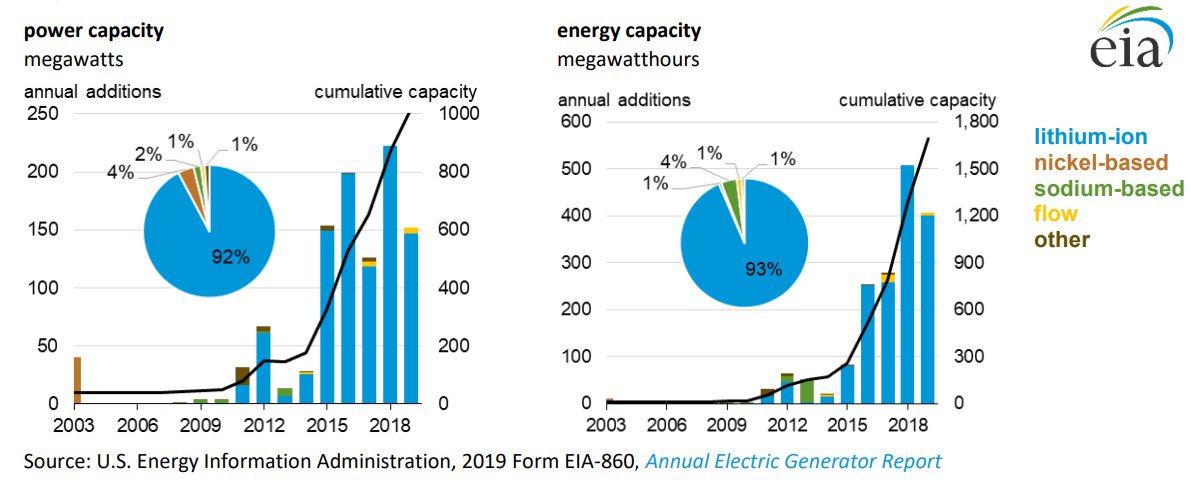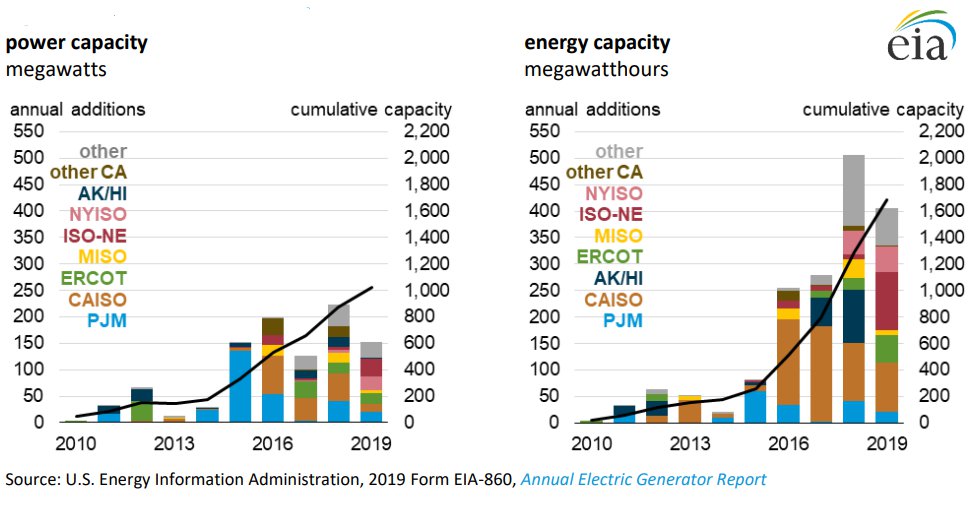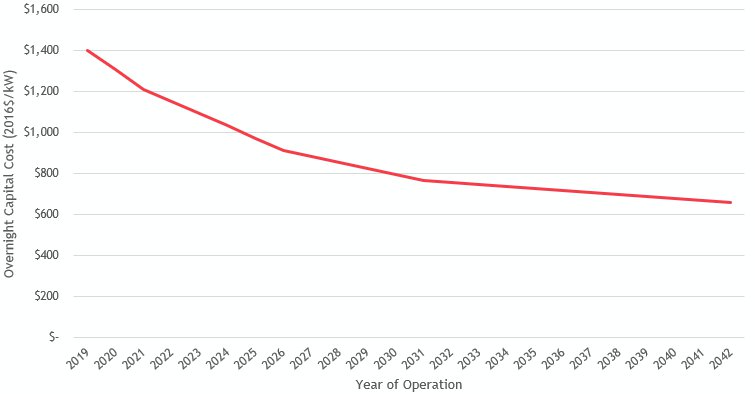Utility-scale Battery Storage
Jump to: Trends, Considerations, and Resource Potential | Description of Reference Plant
Energy storage allows for the capture and storage of energy for use at a later time, when it is discharged back to the grid. While there are many energy storage technologies in commercial operation, the Council’s focus is on the applicable technologies with most potential in the region – battery storage and pumped storage (see pumped storage reference plant) – both categorized as primary resources and developed into full reference plants for the first time in the 2021 Power Pan. However, the plan does encourage utilities and regional entities to explore the suitability and efficacy of additional alternative cost-effective resources – including other energy storage technologies or other battery chemistries – if applicable to their needs.
Utility-scale, standalone (not paired directly with a generating resource) battery storage allows for the capture and storage of energy for a future use. Conventional batteries are composed of cells which contain two electrodes - a cathode and an anode - and electrolyte in a sealed container. During discharge a reduction-oxidation reaction occurs in the cell and electrons migrate from the anode to the cathode. During recharge, the reaction is reversed through the ionization of the electrolyte. Many different combinations of electrodes and electrolytes have been developed. Battery storage systems are not geographically dependent and can be utilized at multiple locations and for a variety of applications.
Lithium-ion (Li-Ion) battery technology has long been used in consumer electronics and electric vehicles, and is now emerging as the dominant choice for battery storage systems. Utility-scale Li-Ion batteries are typically a collection of tens of thousands of small batteries (approximately AA size) connected and packaged together to form a larger resource. The fundamental composition of each cell is several stacks of brittle thin film anode/cathode pairs separated by an electrolyte. During discharge, lithium ions migrate from the anode into the porous crystalline solid cathode to form a chemical bond which releases energy through a metal current collector to provide power to the grid.
In the Seventh Power Plan, battery storage was categorized as a secondary resource as it was commercially available but not largely being deployed in the region. The Seventh Plan included an action item (ANLYS-16) to “research and develop a white paper on the value of energy storage to the future power system.” As identified in the action item,
One of the potential constraints to extensive storage development is the ability of the developer and/or investor to capture and aggregate the full value of the storage system’s services in a non-organized market and transform interest and overall system need into revenue streams and project funding. Many of the benefits of large-scale storage are the portfolio effects for an optimized regional system, not just solely to a specific power purchaser, utility or end-user, and therefore it can be difficult to raise funds and seek cost-recovery for storage projects if the purchaser is not directly benefiting from all of the services, or is paying for a service that benefits others who are not also contributing funds.
In response to this action item, the Council developed the “White Paper on the Value of Energy Storage to the Future Power System” in November 2017. This paper explores the regulatory, market, and cost environment for different types of energy storage technologies while also capturing and describing the value stream applications of energy storage and their potential benefits to the power system.
Battery Storage Trends, Considerations, and Resource Potential
Jump to: Technology Trends | Cost Trends | Developmental Trends | Environmental Effects | Resource Potential in Region | Opportunities and Challenges
The following section describes high level trends in technology, cost, and development for battery storage systems. In addition, it identifies resource potential in the region, opportunities and challenges, and environmental effects.
Lithium-ion chemistries have been used almost exclusively at utility-scale battery storage deployments across the United States. One advantage lithium-ion batteries have over other chemistries is that they are light-weight and have a high energy density – the amount of power stored per unit of mass. Per the latest data collected by the U.S. Energy Information Administration (EIA), through 2019, 92% of the utility-scale installations (in megawatts capacity) were lithium-ion, followed distantly by nickel-based chemistries at 4%. Other chemistries include sodium-based, lead acid, and flow batteries. Power capacity (MW) is defined as the maximum amount of energy that can be discharged from the battery to the grid at any time (instantaneously), and energy capacity (MWh) is the amount of maximum energy that can be stored in the battery.
EIA: Utility-scale Battery Storage Chemistries

Utility-scale battery storage costs have been declining over the past decade. As the volume of batteries produced increases globally to meet rising demand for battery storage and electric vehicles, the cost been driven down. The figure below shows the data plots and analysis that were used to develop the 2021 Power Plan reference plant cost estimates. Note that this figure captures data from various utility-scale standalone battery capacities, durations, and technologies.
Overnight Capital Cost of Utility-Scale Battery Storage

The battery pack (the AA battery equivalent) is still the most expensive component of a stand-alone battery storage installation, and yet it has seen substantial price declines over the last decade – upwards of 80% according to a BloombergNEF report in 2019.
While there is very limited battery storage currently installed in the region, there have been sizable installations elsewhere – often spurred on by policies and/or market design (like an organized market where ancillary services have a transactional value). According to the EIA’s Battery Storage in the United States report (August 2021), by the end of 2019, there were 163 utility-scale battery storage systems installed with a total energy capacity of 1,688 MWh (the total amount stored in the battery) and power capacity of 1,022 MW (the amount that can be discharged at any moment).
Utility-scale Battery Storage Installations in the U.S.

EIA’s Battery Storage in the United States report also noted that while most (62%) of the utility-scale battery installations through 2020 were standalone battery storage systems, the expectation going forward is that more installations will be co-located with generating resources. These hybrid plants will most commonly pair battery with renewable energy to take advantage of surplus energy or to help shape the generation. See the Solar + Battery reference plant for more information.
See the Environmental Effects of Generating Resources for a high-level summary of some of the primary environmental effects of battery storage. For an in-depth description of the lifecycle impacts associated with electricity generation, see Appendix I of the Seventh Power Plan.
The battery storage reference plant considered and assessed by the Council for the 2021 Power Plan are assumed to comply with existing environmental regulations governing air and water emissions, siting regulations, waste disposal, and fish and wildlife protection and mitigation costs when quantifiable and directly attributable to the new resource. Extensive environmental impact statements throughout the siting and licensing process as authorized by FERC are accounted for in the overall project cost. For more information, see the section on Federal Statutes and Regulation Updates and the Methodology for Determining Quantifiable Environmental Costs and Benefits and Due Consideration.
Resource Potential in the Region
There are no limiting factors in terms of development for standalone battery in the region. Declining costs are making batteries more competitive, so utilities and energy service providers will be assessing their systems needs and deciding if a standalone battery system is a cost-effective solution to meet those needs. With the anticipated surge in variable energy renewable resource development over the next decade, battery storage systems strategically situated around the region may make sense to aide in firming the resources (smoothing out variable generation by supplementing with the wind drops or clouds cover a solar panel) and prevent excessive curtailment (when there is an oversupply of generation to meet load or inadequate transmission available to deliver electricity over a certain quantity, the resource’s output is reduced). However, with the cost of solar and wind so low, it is often economical to develop plants without battery storage, even with the expectation of curtailment.
There are currently few standalone battery projects proposed in the region, although there are almost 3,000 megawatts of proposed projects that co-locate a renewable resource with a battery (see utility-scale PV + battery storage).
Energy storage can provide a multitude of ancillary services to the power system. In the region, energy is primarily transacted through bilateral agreements. Much of the rest of the United States operates in an organized market, which is facilitated by an independent system operator (ISO) that creates and manages an auction for generators and consumers to buy and sell energy, ancillary services, and potentially capacity as well - depending on the region. This is a significant structural difference in that, for example, the cost of specific ancillary services in a wholesale market has an explicit transaction-based value whereas a utility operating in a region without a wholesale market may choose to provide ancillary services using their own assets without specifically calculating the implicit cost of doing so. Not having access to clear market signals can challenge a utility or regulator executing a least-cost comparative analysis during planning. Finding a way to assign transactional value to storage in a bilateral market like the Pacific Northwest remains a challenge.
One of the benefits energy storage could play in the Pacific Northwest, where the transmission system is established and contractually encumbered in many places, is to strategically locate battery storage systems along key transmission and distribution paths and substations. By locating energy storage along heavily loaded transmission and distribution paths, the battery storage system can be dispatched during times of peak demand to reduce transmission needs from distant generating resources and ease substation transformer loading. An additional value of energy storage is the ability to defer transmission and distribution upgrades. These potential benefits are very location specific and would require that planners evaluate segments of their distribution system during resource planning. In the 2021 Plan’s recommendations for research and development, the Council recommends that the region explore these – and others, like targeted demand response - non-wires alternatives to address transmission and distribution constraints.
Description of Battery Storage Reference Plant
The standalone battery storage reference plant is a 100 megawatt/400 megawatt-hour, 4-hour lithium-ion battery system. The roundtrip efficiency, the amount of energy that is able to be discharged compared to the amount that was originally charged into the battery, is 88% (essentially meaning that 12% of the initial charge is lost). The reference plant assumes all surrounding infrastructure and necessary equipment are included in the cost, for example all buildings, in-plant electrical and control systems, SCADA, on-site roads, step-up transformers, switchgear and interconnection facilities, and security, control, and maintenance facilities.
Battery Storage: 2021 Power Plan Reference Plants
| Reference Plant | Standalone Battery Storage – 4hr |
| Technology Type | Lithium Ion |
| Configuration | 100 MW, 400 MWh |
| Nameplate Capacity (MW) | 100 MW |
| Location | – |
| Avg. Annual Capacity Factor | – |
| Round-trip Efficiency | 88% |
| Heat Rate – HHV (Btu/kWh) | – |
| Economic Life (Years) | 15 |
| Tax Benefits | – |
| Financial Sponsor | IOU |
| Development Period (Yrs) | 1 |
| Construction Period (Yrs) | 1 |
| Earliest In-Operation Date | 2021 |
| Overnight Capital Cost ($/kW) | $1,400/kW |
| All-in Capital Cost (pre-tax benefits) ($/kW) | $1,473/kW |
| All-in Capital Cost (w/ tax benefits) ($/kW) | – |
| Fixed O&M Cost ($/kW-yr) | $31/kW-yr |
| Variable O&M Cost ($/MWh) | $0/MWh |
| Transmission | IOU NT |
| Deferred Transmission and Distribution ($/kW-yr) | $9.93/kW-yr |
| Maximum build-out (MW) | 10,000 MW (100 units) |
*All costs in 2016 year dollars. For more details and definitions of resource attributes, see Definitions of Reference Plant Components.
Maximum buildout: The maximum buildout potential for standalone battery storage resources follows the maximum buildout methodology.
Forward capital cost curves: The overnight capital cost of the utility-scale battery reference plant is projected to decline 53% by the end of the planning period. The most significant cost declines occur in the first ten years, followed by a more level decrease starting in 2031. The de-escalation is based on the 2019 NREL ATB, storage - mid projection.
Utility-scale Battery – Capital Cost (2016$/kW)

More information: For background analysis, see the initial presentation on utility-scale battery reference plants from the September 2019 GRAC meeting. Please note that some of the material in the presentation may have been updated between that meeting and the draft plan. In addition, see the capital/FOM/VOM cost workbooks for all resource reference plants as well as MicroFin for supplementary inputs and analysis.


